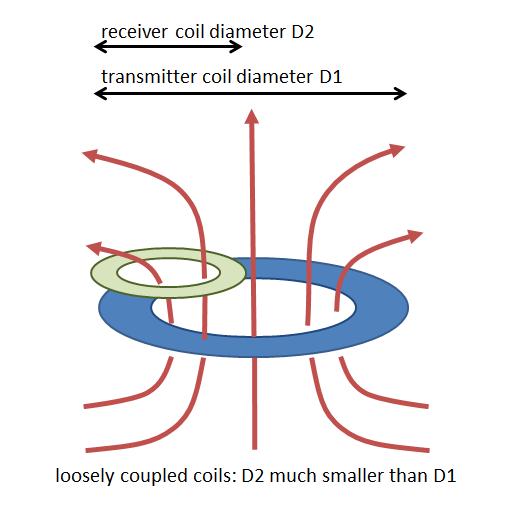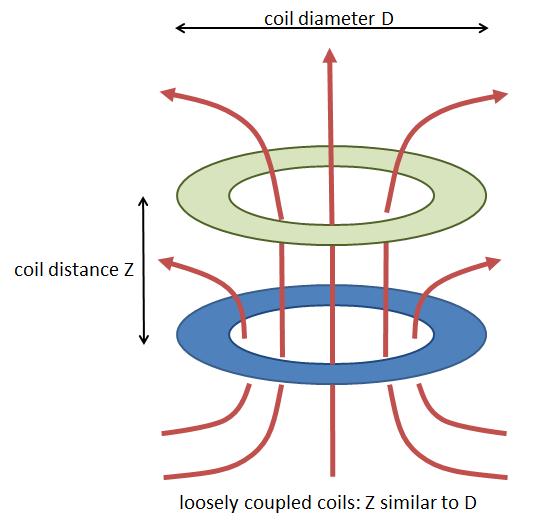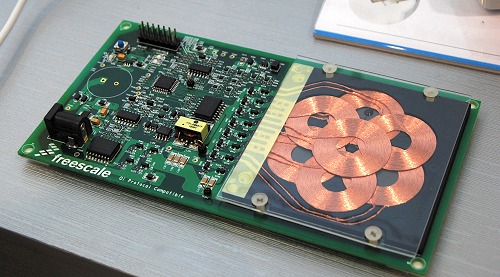The State of Wireless Charging Standards in Mobile
by Andrei Frumusanu on April 2, 2015 8:00 AM ESTInductive Coupling - The Basics
With the history of wireless charging out of the way, the remaining is question is how does it all work? To start, we need to understand the basics of inductive coupling.
Power transfer of inductive coupling happens by creating an alternating magnetic field on the transmitter coil, that magnetic flux is then converted into an electrical current in the receiver coil. The generated electrical current depends on the amount of flux generated by the transmitter coil, and how much of a percentage the receiver coil is able to capture. The distance, size, and positioning of the receiver coil relative to the transmitter coil decides the “coupling factor” of the two coils.
A higher coupling factor means a more efficient power transfer through loss reduction and less heating. In general, we differentiate between tightly coupled and loosely coupled systems.

Source: WPC
In tightly coupled systems, the transmitter and receiver coils both are of the same diameter size and aligned with each other with a minimal distance in-between them. This setup ensures most of the magnetic flux is captured by the receiver coil to be able to be converted into an electrical current.
Loosely coupled systems are defined by setups which do not capture all of the transmitter’s flux, either because the receiver coil distance is too big, or because the coil diameters don’t match and the receiver coil is smaller than the transmitter coil.


Source: WPC
While we mention loosely coupled systems and we’ll get back to them short when investigating Rezence charging, both WPC and PMA standards based on tightly coupled systems.
Optimal alignment of the transmitter to the receiver coil is crucial for a high coupling factor and high efficiency power transmission; because of this, there is a problem of practicality to actually achieve this alignment. To alleviate the issue, Qi transmitters allow for multiple transmitter coils that may overlap.

Source: WPC
By employing multiple transmitter coils over each other, we have a greater area of “optimal coupling” over which a device can be placed on. The control IC of the charging system will then detect which coil is best suited for the power transmission and then use that one for generating the magnetic flux. It is also possible to power on multiple coils simultaneously to achieve a higher power transfer if the receiver device is designed for it.
WPC & PMA Power Control
In Qi and PMA based systems, control over how the coils are powered is done via data communication between the transmitter and the receivers. This is done via data modulation (Either amplitude or frequency based) on the power carrier frequency. The in-band communication requires advanced signal processing and this is where manufacturers’ solution ICs come into play.
WPC wireless power functional diagram, Source: Texas Instruments
This communication is also the main difference and source of incompatibility between the Qi and PMA standards, as without a reliable and interoperable signal the charging process will not start. Powermat differs to Qi by using RFID handshake instead of modulation on the power signal.
The direction of power transfer is always from power transmitter to power receiver. The transmitter idles with in a low power state, which depending on vendor is in the 60mW range. When the power receiver detects a transmitter, it identifies itself to the transmitter as a compliant device and sends configuration information such as the desired charging power. Once power transfer is initiated, the receiver can send error packets requesting more or less power. The power transmission stops upon either receiving an “End Power” message or a period of non-communication of 1.25s.
The coils of a WPC-compliant device operate as resonant half-bridge on a 50% duty cycle with a 19V(±1V) DC power input. Depending on power demand, the frequency in the coil is modulated between 110 and 205 kHz. Powermat on the other hand works in the 277-357 kHz range.
On the receiver side, WPC gives the manufacturers much more liberty in terms of coil-design. While the transmitter is required to have a certain size and provide certain power for standard’s sake, the receiver is allowed to vary in size to adapt to the device form factor the system is implemented into.
Qi in its first low-power specification allows up to 5W of power transfer, with a revision on newer charging systems allowing up to 10W.
Unfortunately PMA does not publicize the standard’s specifications to non-members, so we don’t have any finer details on how it compares to Qi. It’s nevertheless safe to assume that the basic principles of the two standards work in similar fashion.











90 Comments
View All Comments
Samus - Monday, April 6, 2015 - link
...calmly folds tinfoil hat. places on head.theduckofdeath - Sunday, April 12, 2015 - link
"I slept through physics in school, so I think all radiation causes cancer"....-blanarahul
blanarahul - Thursday, April 2, 2015 - link
" Taking out your charger and looking for a free socket can prove to be hassle."That problem applies to wireless charging too.
The main problem we face is the lack of 'standardized charging' and NOT 'standardized wireless charging'. But that will hopefully be fixed by USB Type C. It can be used to charge anything from smart watches to laptops.
theduckofdeath - Sunday, April 12, 2015 - link
You almost got it right, just the wrong way around. I'm all with Samsung on this. Wireless charging IS what will charge everything from laptops to watches in a few years. USB type C is the wrong solution, especially for watches which are supposed to be a lot more water resistant than things like phones.phoenix_rizzen - Sunday, April 5, 2015 - link
"Looking for a free outlet for the charger" is a red herring.If the wireless charging mat is always plugged in and sitting in one spot waiting for a phone... then why can't you just leave the wired charter plugged in all the time in the same spot, waiting for a phone?
If you never leave the wired charger plugged in, why would you leave the wireless mat plugged in?
Anything you can do with over can be done with the other. The only difference is the maybe 2 second to connect the cable. For devices where the charging port is failing, this is a bonus. For devices where the charging port isn't failing, this is a wash.
Shadowmaster625 - Thursday, April 2, 2015 - link
If you put a red sticker on one side of the cable connector to easily indicated which side goes where, then yes it usually does take two seconds. Sometimes it only takes one second.Lord of the Bored - Friday, April 3, 2015 - link
You still have to pick the cable up, connect it to the device, then set the device down. Wireless charging is literally just "set device down".I don't really think all those power cables are a huge issue, or that the effort of plugging in a cable is killing baby seals or anything. It's a minor aesthetic problem at worst.
The biggest problem(if you can call it that) is that USB cables only go in one way. I miss ye olde barrel connectors. I SUPPOSE this means I'm saying Apple did something right, though I consider Lightning to be a great idea implemented (exceptionally) poorly. That the cable has four ICs in it(yes, really!) and a couple of fuses is partially proof that the iPhone 5 connector has serious flaws(and partially an attempt at securing cash flow by forcing accessories AND CABLES to be licensed, but that's neither here nor there).
JonnyDough - Saturday, April 4, 2015 - link
Just goes to show how lazy we've really become.Stuka87 - Thursday, April 2, 2015 - link
It is if you have an iPhone. The lightning connector is just awesome. It can go in either direction, and slides in very easily. WAY better than micro-USB.mr_tawan - Friday, April 3, 2015 - link
With the only condition which is ... all of your devices are iOS and equipped with Lightning. If you happens to use multiple chargers with multiple device mixed with those microUSB you'd ended up with having hassle with cables and adapters.I'd love to see USB-C in the next iPhone, though those Lightning-device owner would cry a lot....